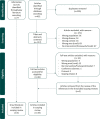Culturally safe interventions in primary care for the management of chronic diseases of urban Indigenous People: a scoping review
- PMID: 35523458
- PMCID: PMC9083425
- DOI: 10.1136/fmch-2022-001606
Culturally safe interventions in primary care for the management of chronic diseases of urban Indigenous People: a scoping review
Abstract
Objectives: Chronic conditions represent an important source of major health issues among Indigenous People. The same applies to those, who live off-reserve and in urban areas. However, very few healthcare services are considered culturally safe, resulting in some avoidance of the public healthcare system. Our goal was to review the literature on culturally safe practices available to urban Indigenous People who suffer from chronic diseases.
Design: We conducted a scoping review to determine what culturally safe healthcare services are currently offered for the management of chronic conditions in urban Indigenous populations, to contribute to a tailored, holistic and safe space in mainstream healthcare systems.
Eligibility criteria: Peer-reviewed original research articles had to be published by 27 October 2020, in English or French.
Information source: In October 2020, we searched five academic databases (EBSCO, PsycArticles, SocINDEX, MEDLINE and PsycINFO) and also reviewed grey literature and the websites of organisations or governments. The data were extracted and collected in an EXCEL spreadsheet. Two reviewers independently screened 326 titles and abstracts, followed by an independent evaluation of 48 full text articles. A total of 19 studies were included in this scoping review, as well as 5 websites/documents from the grey literature.
Results: In total, 19 studies were included in our analysis. We found that Elders, family and the assistance of an interpreter are crucial elements to include to make urban Indigenous feel safe when they seek healthcare services. With this scoping review, we report interventions that are successful in terms of healthcare delivery for this population. Our findings provide insight on what services should be in place in mainstream healthcare settings to create a culturally safe experience for urban Indigenous People.
Conclusions: In recent years, there appears to be a growing awareness of the need to provide culturally safe health services. This scoping review identified multiple strategies to promote cultural safety in this context, as well as barriers and facilitators to their implementation. These elements, which have been extensively documented in the literature, should be included in the chronic diseases management interventions to be developed by urban and primary care settings.
Keywords: chronic disease; health services research; health services, indigenous; patient acceptance of health care; urban health services.
© Author(s) (or their employer(s)) 2022. Re-use permitted under CC BY-NC. No commercial re-use. See rights and permissions. Published by BMJ.
Conflict of interest statement
Competing interests: None declared.
Figures
Similar articles
-
Beyond the black stump: rapid reviews of health research issues affecting regional, rural and remote Australia.Med J Aust. 2020 Dec;213 Suppl 11:S3-S32.e1. doi: 10.5694/mja2.50881. Med J Aust. 2020. PMID: 33314144
-
Characteristics of Indigenous primary health care models of service delivery: a scoping review protocol.JBI Database System Rev Implement Rep. 2015 Nov;13(11):43-51. doi: 10.11124/jbisrir-2015-2474. JBI Database System Rev Implement Rep. 2015. PMID: 26657463
-
Drivers of access to cardiovascular health care for rural Indigenous Peoples: a scoping review.Rural Remote Health. 2024 May;24(2):8674. doi: 10.22605/RRH8674. Epub 2024 May 3. Rural Remote Health. 2024. PMID: 38697785
-
Cultural security in the perinatal period for Indigenous women in urban areas: a scoping review.Women Birth. 2019 Oct;32(5):412-426. doi: 10.1016/j.wombi.2019.06.012. Epub 2019 Jun 29. Women Birth. 2019. PMID: 31262706
-
Indigenous-specific cultural safety within health and dementia care: A scoping review of reviews.Soc Sci Med. 2022 Jan;293:114658. doi: 10.1016/j.socscimed.2021.114658. Epub 2021 Dec 16. Soc Sci Med. 2022. PMID: 34942579
Cited by
-
The cultural safety of research reports on primary healthcare use by Indigenous Peoples: a systematic review.BMC Health Serv Res. 2024 Jul 31;24(1):873. doi: 10.1186/s12913-024-11314-3. BMC Health Serv Res. 2024. PMID: 39085815 Free PMC article.
-
Bridging the Gaps: Strengthening Patient Engagement and Interprofessional Telehealth in Primary Care: Response to Your Insightful Commentary on Our Scoping Review.J Prim Care Community Health. 2025 Jan-Dec;16:21501319251362656. doi: 10.1177/21501319251362656. Epub 2025 Jul 31. J Prim Care Community Health. 2025. PMID: 40742546 Free PMC article. No abstract available.
-
Experimental studies testing interventions to promote cultural safety, interculturality or antiracism in healthcare: protocol for a systematic review.BMJ Open. 2024 Jan 3;14(1):e077227. doi: 10.1136/bmjopen-2023-077227. BMJ Open. 2024. PMID: 38171628 Free PMC article.
-
Indigenous oral health equity: The path forward.Can J Dent Hyg. 2025 Jun 1;59(2):107-115. eCollection 2025 Jun. Can J Dent Hyg. 2025. PMID: 40809528 Free PMC article. Review.
-
The Influence of Sociocultural Determinants on the Number of Diagnosed Chronic Illness Reported by Indigenous Peoples in Canada and the United States During SARS-CoV2.J Prim Care Community Health. 2025 Jan-Dec;16:21501319251354833. doi: 10.1177/21501319251354833. Epub 2025 Jul 4. J Prim Care Community Health. 2025. PMID: 40613357 Free PMC article.
References
-
- Australian Institute of Health Welfare, . Australia’s health 2016. AIHW: Canberra, 2016.
-
- Australian Bureau of Statistics . Australian Aboriginal and Torres Strait Islander health survey: biomedical results, 2012–13. In: Statistics ABO. A.B.o. Statistics, 2015.
-
- Earle L. Undrestanding chornic disease and the role for traditional approaches in Aboriginal communities, 2013: 8.
Publication types
MeSH terms
LinkOut - more resources
Full Text Sources
Medical

